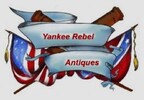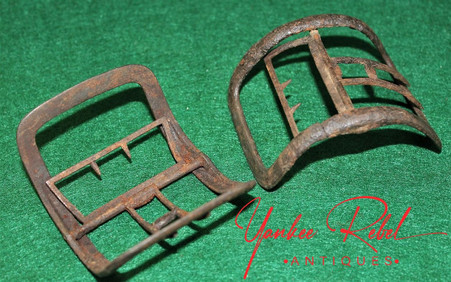 Loading... Please wait...
Loading... Please wait...-
Call us on (973) 810-2976
- My Account
- Gift Certificates
- Items / $0.00
All prices are in All prices are in USD
Categories
- Home
- Non-excavated Artifacts
- Rare, matched set of Revolutionary War Military Shoe Buckles
- Home
- Personal Items
- Rare, matched set of Revolutionary War Military Shoe Buckles
- Home
- REDUCED PRICE ITEMS
- Rare, matched set of Revolutionary War Military Shoe Buckles
- Home
- Late 18th Century / Early 19th Century
- Rare, matched set of Revolutionary War Military Shoe Buckles
- Home
- Revolutionary War items
- Rare, matched set of Revolutionary War Military Shoe Buckles
- Home
- Belt Plates, Box Plates, buckles
- Rare, matched set of Revolutionary War Military Shoe Buckles
Rare, matched set of Revolutionary War Military Shoe Buckles
Product Description
Being offered are a matched pair of Revolutionary War Shoe Buckles, circa 1720s - 1790s. They are made of iron and measure 4 ¼” x 2 ¾”. This large size is typical of what the military was using during the Revolutionary War, both American and English.
Shoe buckles came into fashion for men in the middle of the 17th century. Samuel Pepys, quoted above, gives us one of the earliest written records of the practice. They were used almost exclusively until 1790 when the French Revolution brought about a shift towards less ostentation in daily dress. However, shoes were not sold with buckles already attached, they had to be purchased separately.
During the 18th century, buckle making was a large trade in England, according to Chambers’ Encyclopedia: A Dictionary of Universal Knowledge, Volume II: “In the latter half of the 18th century the manufacture of buckles was carried on most extensively in Birmingham, there being at one time not less than 4000 people directly employed in that town and its vicinity, who turned out 2,500,000 pairs of buckles annually, the prices ranged from one shilling to five guineas, and even ten guineas a pair.”
These buckles were made from a variety of metals; silver, brass, iron, steel, copper, and pewter were common choices, and could be plain or very flashy incorporating real or paste gemstones, commemorative motifs, or pleasing designs. One could easily change the look of an average shoe by giving it a good blacking and putting an eye-catching buckle on it. The parts of a shoe buckle. When the buckle is set onto the shoe, everything but the rim (which some call the frame) is hidden by the buckle straps.
I have had single shoe buckles in the past, but this is the first matching set I was able to acquire. They are in excellent condition and only have some slight surface rust from many years of storage. Examples can be found in the “Collectors Illustrated Encyclopedia of the American Revolution” and in Colonial Williamsburg (see pictures). They came out of the New England area, which was very active during the Revolutionary War.



